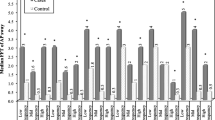Abstract
Judgement of the ability to recover balance after a sudden shoulder pull is used as a clinical measure of postural instability in Parkinson’s disease. To further evaluate its merits, we compared this ‘retropulsion test’ with dynamic posturography in 23 Parkinson patients. Dynamic posturography involved 20 serial ‘toe-up’ support surface rotations, which induced backward body sway. We found a moderate correlation (Spearman’s ρ = 0.54; P < 0.05) between the retropulsion test and body sway after platform rotations during the ‘off’ phase, but no correlation during the ‘on’ phase (Spearman’s ρ = 0.43; P = 0.11). These results cast doubt on the use of the retropulsion test as a measure of postural instability in Parkinson’s disease.
Similar content being viewed by others
Author information
Authors and Affiliations
Additional information
Received: 1 August 1997 Received in revised form: 3 February 1998 Accepted: 16 March 1998
Rights and permissions
About this article
Cite this article
Bloem, B., Beckley, D., van Hilten, B. et al. Clinimetrics of postural instability in Parkinson’s disease. J Neurol 245, 669–673 (1998). https://doi.org/10.1007/s004150050265
Issue Date:
DOI: https://doi.org/10.1007/s004150050265




